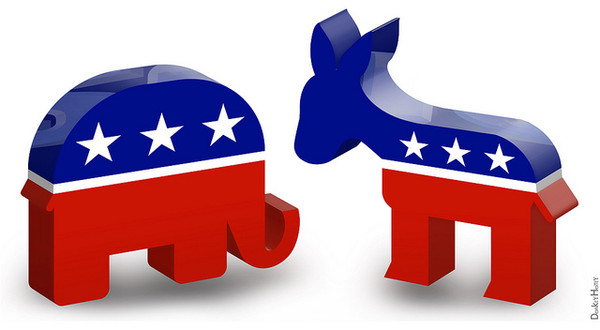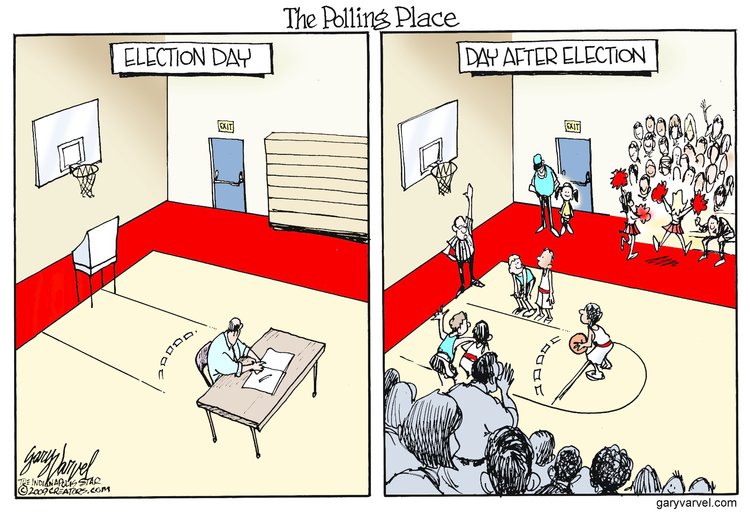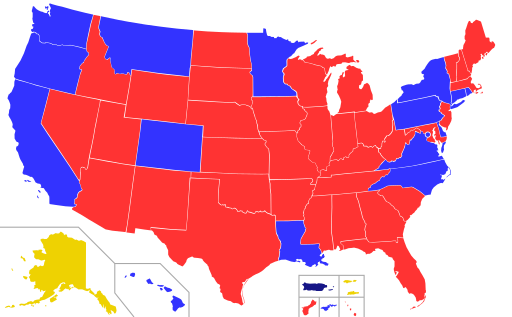“The ignorance of one voter in a democracy impairs the security of all.”
~ President John F. Kennedy
2017 General Elections
(For info on the 2016 Presidential Election, visit Student News Daily’s
2016 Presidential Election page.)

The United States general elections of 2017 will be held on Tuesday, November 7.
This off-year election will feature gubernatorial elections in Virginia and New Jersey, as well as state legislative elections in both houses of the New Jersey Legislature and in the lower house of the Virginia legislature. Numerous citizen initiatives, mayoral races, and a variety of other local elections will also occur. Five Special elections to the United States House of Representatives have already taken place, with two other House seats and one Senate seat still to be filled.
For links to all races by state (federal and local), go to Ballotpedia and click on your state. You will find information on all races on your state page.
SENATORS/REPRESENTATIVES/GOVERNORS:
SENATORS:
- Did you know that a third of the Senate is up for election every two years? — read about it at: Wikipedia.
- This year is not one of those years – it is an off-year. Only special elections will be held to replace Senators who resigned in the 115th U.S. Congress: The only Senate race is for Alabama: Incumbent Senator Jeff Sessions was confirmed by the Senate to serve as U.S. Attorney General on February 8, 2017, and subsequently resigned from the Senate. Governor Robert J. Bentley chose Luther Strange, the Attorney General of Alabama, to succeed Sessions, filling the seat until the special election takes place. Although he had the power to schedule an election in 2017, Bentley decided to align it with the 2018 general election. Following Bentley’s resignation in April 2017, Governor Kay Ivey decided to reschedule the elections. The primary election took place on August 15 with Doug Jones winning the Democratic nomination. Roy Moore was nominated as the Republican candidate on September 26. The general election is scheduled for December 12.
- Special elections may also be held to fill vacancies that occur during the 115th Congress.
- Republicans, having taken control of the Senate in the 2014 election, currently hold the Senate majority with 52 seats. There are 46 Democrats and 2 independent senators (both of whom caucus with the Democrats: democratic socialist Bernie Sanders of Vermont and Angus King of Maine).
- Note: The 2014 elections marked 100 years of direct elections of U.S. Senators. Do you know which amendment established this policy? (see wikipedia for the answer)
REPRESENTATIVES: The House is currently composed of 239 Republicans and 194 Democrats and 2 vacancies.
2017 is an off-year election. The following congressional elections took/will take place:
- California’s 34th congressional district: Democrat Xavier Becerra resigned to become the Attorney General of California. The primary election was held on April 4, 2017. With no candidate receiving 50% of the vote, a runoff between the top two candidates, Democrats Jimmy Gomez and Robert Lee Ahn, was held June 6. Gomez defeated Ahn 60.1% to 39.9% to become the new representative.
- Georgia’s 6th congressional district: Republican Tom Price resigned February 10, 2017, to become the U.S. Secretary of Health and Human Services. A special election was held on April 18, 2017. A runoff was held on June 20, 2017, and was won by Republican Karen Handel.
- Kansas’s 4th congressional district: Republican Mike Pompeo resigned January 23, 2017, to become Director of the Central Intelligence Agency. A special election was held on April 11, 2017, and won by Ron Estes, the Republican Kansas State Treasurer.
- Montana’s at-large congressional district: Republican Ryan Zinke resigned March 1, 2017, to become the U.S. Secretary of the Interior. Republican Greg Gianforte, a businessman and nominee for the previous year’s gubernatorial race, defeated Democrat Rob Quist and Libertarian Mark Wicks 49.7% to 44.1% and 5.7%.
- South Carolina’s 5th congressional district: Republican Mick Mulvaney resigned February 16, 2017, to become the Director of the Office of Management and Budget. A special election was held on June 20, 2017, and was won by Republican Ralph Norman.
- Utah’s 3rd congressional district: Republican Jason Chaffetz resigned June 30, 2017 for health reasons. Governor Gary Herbert scheduled a special election, the primary was held on August 15 and the general election will be held on November 7.
- Pennsylvania’s 18th Congressional District: Republican Tim Murphy submitted his letter of resignation, effective October 21, 2017 following allegations that he had an extramarital affair and acted in a scandalous manner. A special election will be held on March 13, 2018. Primary elections will not be held in the race. Instead, nominees will be chosen by each party. The Democratic Party will hold a special convention on November 19, 2017, to decide on a nominee.
- For information on these elections, go to ballotpedia.org.
Visit govtrack.us (NOTE: Don’t enter your address, use 2nd box to just choose your state) to find out how Democrats and Republicans in general, as well as your members of Congress, have voted on any proposed legislation. GovTrack says it “helps ordinary citizens find and track bills in the U.S. Congress and understand their representatives’ legislative record.”
QUESTION:
Discuss how the majority party in both houses affects proposed legislation and also the federal government’s budget, spending and taxation.
See Wikipedia for a brief explanation.
GOVERNORS: Currently, there are 34 Republicans, 15 Democrats, and 1 independent who hold the office of governor. Additionally, Ricky Rosselló is registered with the New Progressive Party of Puerto Rico but nationally affiliated as a Democrat. The mayor of the District of Columbia, Muriel Bowser, is a Democrat.
Two states will hold gubernatorial elections in 2017:
- New Jersey: Two-term Republican Chris Christie is term-limited in 2017. Christie campaigned for the 2016 Republican presidential nomination, but withdrew from the race February 10, 2016. Republican Kim Guadagno is running against Democrat Phil Murphy.
- Virginia: One-term Democrat Terry McAuliffe is term-limited in 2017. Democrat Ralph Northam is running against Republican Ed Gillespie.
- For information on current governors, do an internet search for your governor’s official website and/or go to the National Governors Association website: nga.org/cms/governors/bios
QUESTION:
Name the candidates running for office in your state. Include party affiliation and office each candidate is running for.
The map below from wikipedia is a list of current governors as of October 2017:
Blue – Democratic/Popular Democratic Governor
Red – Republican Governor
Yellow – Independent Governor
STATE ELECTION WEBSITES:
Links for all 50 states’ Election Board websites are provided here. (Note: Many states include information and/or links to candidates’ websites.)
QUESTIONS:
Visit your state’s official election webpage.
1. What requirements does a prospective candidate need to complete to have his/her name on the ballot in your state?
2. What type of information would you like to see on your state’s elections page? Send an email to your state’s Secretary of State with your suggestion. Identify yourself with your name, school and city. Be clear, concise and polite. (Find contact information for your Secretary of State on your state’s election page, or for a list of all state Secretaries, go to: nass.org/contact/sos-members)
CHALLENGE QUESTION: What issues are important to voters in your state in the upcoming election? How do the opposing candidates stand on the issues?
For links to all races by state (federal and local), go to Ballotpedia and click on your state. You will find information on all races on your state page – or go to Ballotpedia’s 2017 State Legislative Elections page
CONSERVATIVE vs. LIBERAL BELIEFS:
Check out StudentNewsDaily’s “Conservative vs. Liberal Beliefs” chart. [NOTE: This is a general overview of the conservative and liberal positions on the issues.]
QUESTION:
Read through the chart. For each issue, state which position best represents your beliefs and explain why.
PARTY PLATFORMS:
A National Platform is the official statement of a political party’s position on a wide variety of issues. Each issue category included in the Platform is a “plank.” A new Platform is adopted every four years by both the Democratic and Republican parties and is generally approved during the party’s national convention.
2016 Republican Party Platform (compare to 2012 Republican Party Platform)
2016 Democratic Party Platform (compare to 2012 Democratic Party Platform) – [NOTE: 2012 Platform was passed during convention on 9/4/12 and amended to add mention of God and Jerusalem on 9/5/12.]
View all current and previous party platforms at The American Presidency Project.
See also: 2016 Libertarian Party platform (first revised in 2014; before 2014, the last platform was created in 1972),
Constitution Party Platform and the Green Party platform)
QUESTIONS:
How specific or detailed is each party on its positions on the issues?
1. Choose 3 issues and summarize each party’s position on those issues.
2. For each issue, explain if you believe the party was specific or vague in stating its position. Why do you think this is so?
3. What role does each party believe the government should take on each issue? (What type of government action and/or legislation, if any, does each party support?)
4. For these issues, how does each party’s position line up with your own?
THE CANDIDATES:
Visit the campaign websites and YouTube pages for candidates running for office in your state/county/city to hear where they stand on the issues.
(To find the candidates’ pages, search for: “‘name of candidate‘ youtube page”)
QUESTIONS:
List 3 issues you believe are important to consider in this election.
1. What does each candidate say he would do to address each issue? (What are his solutions?)
2. What actions have each taken (legislation) to support or undermine his position on each issue?
3. What do you think is the best way to improve the economy and reduce unemployment in your town? Cut taxes? Cut government spending? Raise taxes on the wealthy? (if so, define wealthy) Raise taxes across the board?Consider this: Some people vote for a candidate based on the person’s age, sex, race or religion. Some vote for a candidate because he/she is an interesting or dynamic speaker, is attractive, or looks like a leader. Before you are eligible to vote, decide that you will vote for a candidate based on his/her positions on the issues.
NOTE: The U.S. has a two-party system, which distinguishes American government from most other democracies. Most Western democracies, particularly those in Europe, have multiparty elections and parliaments, but the American government traditionally has had a two-party system. Since the Civil War the two parties have been the Republican Party and the Democratic Party.
From time to time, third parties have gained traction with the electorate, most recently the Reform Party, led by Ross Perot, who won 19% of the popular vote in the 1992 presidential election. Third parties can sometimes push the major parties to consider their position on a specific issue (generally when they believe the party is not taking a strong enough stand, or is taking a moderate position on the issue). Few third-party candidates hold elected office at the state and national level. There are dozens of “third parties” in the U.S. including the Constitution Party (conservative), the Green Party (liberal) and the Libertarian Party (in general socially liberal, fiscally conservative).
CARTOONS:

Cartoon by Gary Varvel
BALLOT MEASURES:
Anything that appears on a ballot other than a candidate running for office is called a ballot measure. Ballot measures are broken down into two distinct categories – initiatives (or propositions) and referendums.
- Initiative – Citizens, collecting signatures on a petition, place advisory questions, memorials, statutes (laws) or constitutional amendments on the ballot for the citizens to adopt or reject. “Initiative” refers to newly drafted legislation submitted directly to a popular vote as an alternative to adoption by a state legislature. Twenty-four states have the initiative process.
- Referendum – In many of the same states the citizens have the referendum process – the ability to reject laws or amendments proposed or already passed by the state legislature.
The terms above are all forms of “direct democracy” practiced by various states. In a direct democracy, all citizens, without the intermediary of elected or appointed officials, can participate in making public decisions. Ballot measures are a form of direct democracy practiced by many states in the U.S.
Read more about ballot measures (initiatives and referendums) at the Initiative and Referendum website iandrinstitute.org.
View a list that shows what type (if any) of ballot measures your states allows at iandrinstitute.org.
For a map of ballot measures on your state’s ballot for 2017, go to: ballotpedia.org
Find a list of all state and local ballot measures by topic at: ballotpedia.org_List_of_ballot_measures_by_topic
or all ballot measures by state at: ballotpedia.org/2017 ballot measures
QUESTION:
Does your state practice direct democracy through the ballot measure process?
If so, what initiatives or referendums are on your state’s ballot in the upcoming election?
If there are ballot measures in your state, how would you cast your vote on each question?
DEBATES:
The central focus of a debate should be to provide voters with information they need to measure the suitability of the candidates for office.
Are any candidates holding debates for your state or local offices?
CHALLENGE QUESTION:
Attend a local debate between the candidates. Pay attention to the questions the moderator asks.
Did the moderator’s questions cause each candidate to clearly explain his position on each issue? Explain your answer.
PRESIDENTIAL ELECTIONS – THE ELECTORAL COLLEGE:
The Electoral College consists of popularly elected representatives (electors) who formally elect the President and Vice President of the United States. Since 1964, there have been 538 electors in each presidential election. Article II, Section 1, Clause 2 of the Constitution specifies how many electors each state is entitled to have and that each state’s legislature decides how its electors are to be chosen. U.S. territories are not represented in the Electoral College. The Electoral College is an example of an indirect election.
Electoral Votes for the presidential election: Each state has a certain number of electoral votes. The more people who live in your state, the more electoral votes your state gets. (Can you see why candidates would spend a lot of time in California, New York, and Texas?) In 48 of the states, the candidate who gets the most votes gets all the electoral votes for that state. Nebraska and Maine do not follow the winner-take-all rule – there could be a split of electoral votes among candidates through a proportional allocation of votes. The first candidate to win 270 electoral votes becomes the President.
- For more on the electoral college visit the U.S. National Archives and Records Administration.
- Visit the U.S. National Archives page “Frequently Asked Questions” regarding the Electoral College and electors.
- View a map of electoral college votes by state at: 270towin.com
- Take the “Electoral College Quiz” at: 270towin.com/quiz
QUESTIONS:
1. How many electoral votes does your state have?
2. Why is your vote meaningful under the electoral college system?
(This page last updated 3/10/15)
